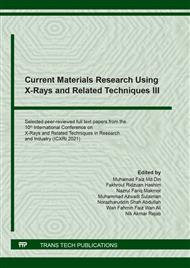[1]
W. Y. Wong, R. A. Shamsudin, M. F. Mohd Nazeri, and M. N. Masri, The Preliminary Study of the Addition Zinc in Tin-Copper Lead Free Solder, Mater. Sci. Forum. 1010 (2020) 104-108.
DOI: 10.4028/www.scientific.net/msf.1010.104
Google Scholar
[2]
M. N. Masri, M. K. Samsudin, M. A. Sulaiman, M. Mohamed, M. F. M. Amin, M. H. M. Amini, M. K. A. A. Razak, N. H. Abdullah, M. B. A. Bakar, M. I. Ahmad, Microscopic Study on the Corrosion of Underground Pipeline, Key Eng. Mater. 694 (2016) 172-176.
DOI: 10.4028/www.scientific.net/kem.694.172
Google Scholar
[3]
H. Kang, S. H. Rajendran, and J. P. Jung, Low Melting Temperature Sn-Bi Solder: Effect of Alloying and Nanoparticle Addition on the Microstructural, Thermal, Interfacial Bonding, and Mechanical Characteristics, Metals.11, 2 (2021) 364.
DOI: 10.3390/met11020364
Google Scholar
[4]
Y.Z. Peng C.J. Li, J.J. Yang, J.T. Zhang, J.B. Peng, G.J. Zhou, C.J. Pu, J.H. Yi, Effects of Bismuth on the Microstructure, Properties, and Interfacial Reaction Layers of Sn-9Zn-xBi Solders, Metals. 11, 4 (2021) 538.
DOI: 10.3390/met11040538
Google Scholar
[5]
M. F. M. Nazeri, M. N. Masri, and A. A. Mohamad, Post-Corrosion Mechanical Analysis of Sn-Zn Alloys: A Short Review, IOP Conf. Ser.: Mater. Sci. Eng.701, 1 (2019) 012049.
DOI: 10.1088/1757-899x/701/1/012049
Google Scholar
[6]
M. Muhamad, M. Masri, M. Nazeri, and A. Mohamad, The Effect of Bismuth Addition on Sn-Ag-Cu Lead-Free Solder Properties: A Short Review, IOP Conf. Ser.: Earth Environ. Sci. 596, 1 (2020) 012007.
DOI: 10.1088/1755-1315/596/1/012007
Google Scholar
[7]
F. S. M. Tarmizi, M. N. Masri, M. F. M. Nazeri, and A. A. Mohamad, Effect Additions Zn on Sn-0.7 Cu Lead-Free Solder: A Short Brief, IOP Conf. Ser.: Earth Environ. Sci. 596, 1 (2020) 012038.
DOI: 10.1088/1755-1315/596/1/012038
Google Scholar
[8]
Z.-L. Wang, M. Wang, L.X. Li, and Y.P. Bao, Permeation behavior of low-melting-point Sn–Bi alloy in the fiber channel of pine wood, Materials & Design. 196 (2020) 109068.
DOI: 10.1016/j.matdes.2020.109068
Google Scholar
[9]
Y. Hirata, C. H. Yang, S. K. Lin, and H. Nishikawa, Improvements in mechanical properties of Sn-Bi alloys with addition of Zn and In, Mater. Sci. Eng.: A. (2021) 141131.
DOI: 10.1016/j.msea.2021.141131
Google Scholar
[10]
C. Luo, X. Qiu, Y. Ruan, Y. Lu, and F. Xing, Effect of Bi addition on the corrosion resistance and mechanical properties of sintered NdFeB permanent magnet/steel soldered joints, Mater. Sci. Eng.: A, 792 (2020) 139832.
DOI: 10.1016/j.msea.2020.139832
Google Scholar
[11]
P. Ranjan, D. H. Nguyen, K. Tanaka, H. Suematsu, R. Jayaganthan, and R. Sarathi, Synthesis, characterisation and formation mechanism of Sn-0.75 Cu solder nanoparticles by pulsed wire discharge, Appl. Nanosci. 9, 3 (2019) 341-352.
DOI: 10.1007/s13204-018-0910-x
Google Scholar
[12]
M. Yusoff, M, Mohamed, M. B. A. Bakar, M. N. Masri, N. Z. Noriman, M. U. S. U. Omar, Copper alloy reinforced by graphene by powder metallurgy technique, AIP Conf. Proc. 2213, 1 (2020) 020264.
DOI: 10.1063/5.0000413
Google Scholar
[13]
S. Li, X. Wang, Z. Liu, Y. Jiu, S. Zhang, J. Geng, X. Chen, S. Wu, P. Hu, W. Long, Corrosion behavior of Sn-based lead-free solder alloys: a review, J. Mater. Sci. Mater. 31 (2020) 9076-9090.
DOI: 10.1007/s10854-020-03540-2
Google Scholar
[14]
S. Cai, X. Luo, J. Peng, Z. Yu, H. Zhou, N. Liu, X. Wang, Deformation mechanism of various Sn-x Bi alloys under tensile tests, Advanced Composites and Hybrid Materials. (2021) 1-13.
DOI: 10.1007/s42114-021-00231-2
Google Scholar
[15]
M. Li, Y. Tang, Z. Li, M. Zhu, and W. Wang, Microstructure and mechanical properties of Sn–58Bi eutectic alloy with Cu/P addition, Mater. Res. Express. 7, 11 (2020) 116502.
DOI: 10.1088/2053-1591/abc4f8
Google Scholar
[16]
M. Mohamad, R. Wannahari, R. Mohammad, N.F. Shoparwe, A.S.M. Nawi, W.L. Kwan, J.W. Lim, Adsorption of malachite green dye using spent coffee ground biochar: optimisation using response surface methodology, J. Teknol. 83:1 (2021) 27-36.
DOI: 10.11113/jurnalteknologi.v83.14904
Google Scholar
[17]
R. Taufik, M. Mohamad, R. Wannahari, N.F. Shoparwe, W.H.W. Osman, P.T. Teo and M.N. Masri, Spent coffee ground as low-cost adsorbent for congo red dye removal from aqueous solution, IOP Conf. Ser.: Earth Environ. Sci. 765 (2021) 012089.
DOI: 10.1088/1755-1315/765/1/012089
Google Scholar


